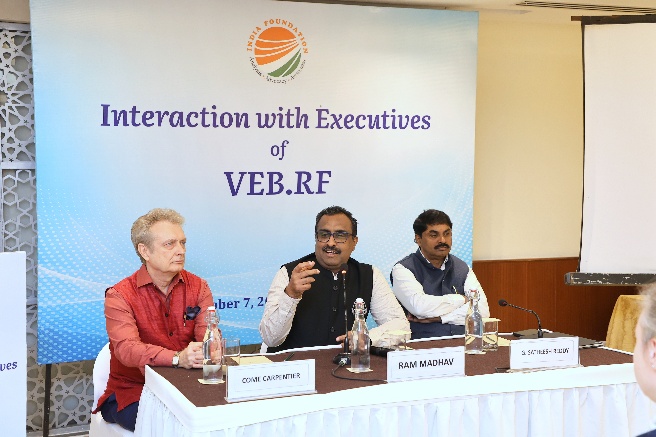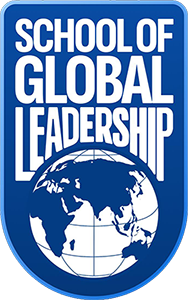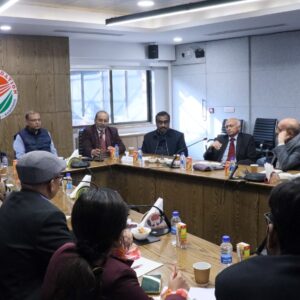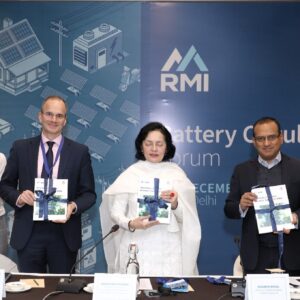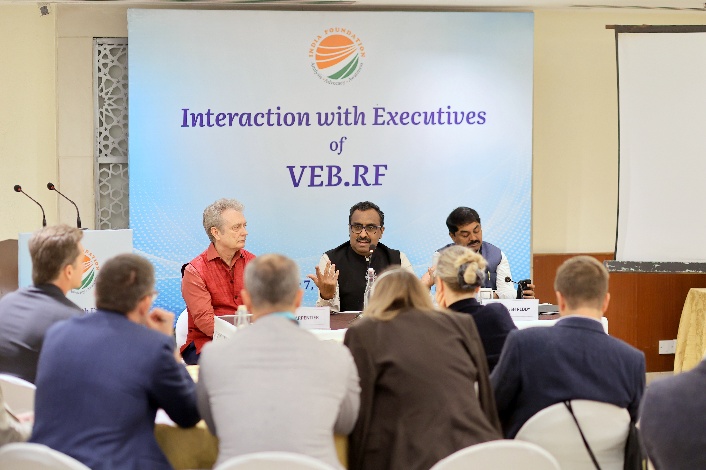
On October 7, 2025, India Foundation organised an interaction with the executives of VEB.RF, a Russian state development corporation and investment company, at Magnolia, India Habitat Centre, New Delhi.
The interaction was chaired by Mr. Côme Carpentier, Distinguished Fellow, India Foundation, and addressed by Dr. Ram Madhav, President, India Foundation, and Dr. G. Satheesh Reddy, Former Chairperson, Defence Research and Development Organisation, and Member, Governing Council, India Foundation.
While welcoming the 35-member delegation to the interaction, Mr. Carpentier underscored the depth of bilateral ties between India and Russia and their importance in the evolving multipolar order. Dr. Madhav, in his address, reiterated the goals of shared growth and prosperity between Russia and India. He underlined the need for India to rise as a strong economy, fulfilling the national priority of becoming a USD10 trillion-economy. Dr. Madhav also directed the delegates’ attention to the need for the empowerment of India’s massive youth population, as well as the steps taken by the government to address it. Describing educational reforms in India, especially the National Education Policy, 2020, he detailed the projects for upskilling the youth and strengthening the tech-driven education in the country.
Speaking of Indo-Russian cooperation in science and technology, he emphasised the strength of India’s information and technology sector and its importance to the Indian economy. He enumerated quantum technology, artificial intelligence, and bio-engineering and genetics as the sectors on which the Indian government is focussing attention. Highlighting the challenges to India’s development story, India’s component dependence for its booming Electronic Vehicle (EV) market on imports is pronounced; developing self-reliance is paramount. Investment in research and development is, as a corollary, expected to catalyse this growth story.
Speaking next, Dr. Reddy spoke of the strategic contours of the bilateral ties between India and Russia. His presentation focussed on the enduring significance of the strategic partnership, along with its evolution from a historically defence-centric relationship into a multifaceted collaboration spanning energy, technology, and innovation. He described how Russia continues to supply a major share of India’s military hardware, with joint ventures in aircraft, tanks, missiles, and naval systems—while new initiatives focus on co-development in drone, radar, AI, and directed-energy technologies. Civil nuclear cooperation remains robust through the Kudankulam project, with future plans for small modular and floating reactors. Economic ties have deepened considerably, with bilateral trade reaching USD 68.7 billion in 2024–25 and a target of USD 100 billion by 2030, supported by new trade routes and diversified exchanges in oil, fertilisers, pharmaceuticals, and steel. He was sanguine about the expansion in scientific and technological collaboration through joint R&D in hyper-sonics, quantum technologies, space, and cyber defence. He mentioned that despite challenges such as sanctions, supply chain delays, and language barriers, the India–Russia relationship is transitioning from a government-to-government model to one emphasizing business partnerships, innovation, and strategic autonomy, positioning both nations to strengthen resilience in a rapidly changing global order.
The session ended with the felicitation of the speakers by representatives of VEB.RF, followed by a noted of thanks by Mr. Carpentier.
